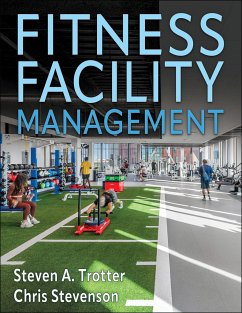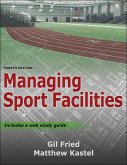- Broschiertes Buch
- Merkliste
- Auf die Merkliste
- Bewerten Bewerten
- Teilen
- Produkt teilen
- Produkterinnerung
- Produkterinnerung
Fitness Facility Management provides an in-depth look at the challenges and rewards of managing contemporary health and fitness facilities, including boutique and corporate facilities, campus recreation centers, community recreation, and franchised fitness clubs.
Andere Kunden interessierten sich auch für
![Security and Risk Assessment for Facility and Event Managers Security and Risk Assessment for Facility and Event Managers]() Stacey HallSecurity and Risk Assessment for Facility and Event Managers95,99 €
Stacey HallSecurity and Risk Assessment for Facility and Event Managers95,99 €![Managing Sport Facilities Managing Sport Facilities]() Gil FriedManaging Sport Facilities127,99 €
Gil FriedManaging Sport Facilities127,99 €![Agribusiness Supply Chain Management Agribusiness Supply Chain Management]() N. ChandrasekaranAgribusiness Supply Chain Management161,99 €
N. ChandrasekaranAgribusiness Supply Chain Management161,99 €![Turnaround, Shutdown and Outage Management Turnaround, Shutdown and Outage Management]() Tom LenahanTurnaround, Shutdown and Outage Management67,99 €
Tom LenahanTurnaround, Shutdown and Outage Management67,99 €![Contemporary Sport Management Contemporary Sport Management]() Contemporary Sport Management96,99 €
Contemporary Sport Management96,99 €![Health Fitness Management Health Fitness Management]() Mike BatesHealth Fitness Management108,99 €
Mike BatesHealth Fitness Management108,99 €![A Handbook of Management Theories and Models for Office Environments and Services A Handbook of Management Theories and Models for Office Environments and Services]() A Handbook of Management Theories and Models for Office Environments and Services227,99 €
A Handbook of Management Theories and Models for Office Environments and Services227,99 €-
-
-
Fitness Facility Management provides an in-depth look at the challenges and rewards of managing contemporary health and fitness facilities, including boutique and corporate facilities, campus recreation centers, community recreation, and franchised fitness clubs.
Hinweis: Dieser Artikel kann nur an eine deutsche Lieferadresse ausgeliefert werden.
Hinweis: Dieser Artikel kann nur an eine deutsche Lieferadresse ausgeliefert werden.
Produktdetails
- Produktdetails
- Verlag: Human Kinetics Publishers
- Seitenzahl: 216
- Erscheinungstermin: 26. November 2024
- Englisch
- Abmessung: 215mm x 280mm x 16mm
- Gewicht: 612g
- ISBN-13: 9781718221253
- ISBN-10: 1718221258
- Artikelnr.: 70600459
- Herstellerkennzeichnung
- Produktsicherheitsverantwortliche/r
- Europaallee 1
- 36244 Bad Hersfeld
- gpsr@libri.de
- Verlag: Human Kinetics Publishers
- Seitenzahl: 216
- Erscheinungstermin: 26. November 2024
- Englisch
- Abmessung: 215mm x 280mm x 16mm
- Gewicht: 612g
- ISBN-13: 9781718221253
- ISBN-10: 1718221258
- Artikelnr.: 70600459
- Herstellerkennzeichnung
- Produktsicherheitsverantwortliche/r
- Europaallee 1
- 36244 Bad Hersfeld
- gpsr@libri.de
Steven A. Trotter, MS, is a global well-being consultant and adjunct professor. With over two decades of experience in the fitness and wellness industry, Trotter is renowned for his expertise in people management and the development of programs and facilities. He founded Globetrotter Wellness Solutions, LLC, in 2017 after seven years of providing independent consulting services. His firm collaborates with universities; health clubs; organizations; and morale, wellness, and recreation (MWR) units to improve organizational and employee well-being and to build systems for success. Trotter was formerly the director of well-being at a major university. During that time, he led a comprehensive, holistic well-being program that served over 35,000 individuals across three campuses and a distance education program. He managed two indoor fitness facilities and several outdoor fitness areas, totaling over 200,000 square feet. In his earlier roles as fitness director at various universities, he was instrumental in managing fitness programs and overseeing numerous facility expansion and construction projects. Trotter is an international speaker and presenter, regularly presenting at local, state, regional, national, and international conferences on subjects such as facility management, employee engagement, organizational development, project and priority management, and strategic marketing. He is a regular contributor to Campus Rec Magazine and the website of American Council on Exercise (ACE). He has served as a subject matter expert for ACE since 2014 and works with the credentialing department to develop and continuously improve the four NCCA-accredited ACE certifications. Trotter has a master of science degree in health and physical education from Virginia Tech and a bachelor of science degree in exercise science from the University of North Carolina at Charlotte. He holds the American College of Sports Medicine (ACSM) exercise physiologist certification, four certifications from ACE, and multiple specialty certifications from Les Mills. He is an American Red Cross instructor in CPR, AED, and first aid; a certified mental health first aid trainer; a Green Dot bystander intervention facilitator; and a Gallup-certified strength coach. He is also a continuing education provider with ACE, National Academy of Sports Medicine (NASM), and Athletics and Fitness Association of America (AFAA). Chris Stevenson, BA, CSCS, is the founder of The Empower Group, a comprehensive consulting firm headquartered in Westlake Village, California. The firm specializes in delivering keynote presentations, interactive workshops, and strategic advising services to facilities worldwide. The Empower Group collaborates with facilities of varying scales and types, spanning domestic and international markets. Their core competencies encompass business planning, strategic design, fostering exceptional workplace culture, optimizing staffing strategies, enhancing marketing and sales efforts, refining member experiences, and more. Stevenson has over 25 years of experience in the health and fitness industry, from personal training and group exercise classes to owning and operating a full-service health club. For six years, he was a faculty member at the California Health and Longevity Institute (CHLI), located at the Four Seasons in Westlake Village, California, and named one of the top 10 executive health programs in the nation by Worth magazine. He presented on exercise science and behavioral change and oversaw a team of exercise specialists who performed one-on-one assessments and training sessions for the executives. Stevenson is an international speaker and has presented keynote speeches and breakout sessions in over a dozen different countries and throughout the United States. He regularly presents at fitness and business events, including those of Health & Fitness Association (formerly IHRSA), Athletic Business, IDEA, NASM Optima, and Club Industry. He has written for Club Business International (CBI), Health Club Management (HCH), Chartered Institute for the Management of Sport and Physical Activity (CIMSPA), National Academy of Sports Medicine (NASM), Club Solutions, and Club Industry, and he is a regular columnist for Athletic Business. He serves on the board of directors of the Health & Fitness Association, the largest nonprofit trade association for the health and fitness industry; the owners committee of IDEA; and the events committee of the Climbing Wall Association. In those roles, he advises on strategic planning, standards, policies, values, and vision to increase the organizations’ benefits to their members. Stevenson has a bachelor of business administration degree from Baldwin Wallace University in Berea, Ohio. He holds the Certified Strength and Conditioning Specialist (CSCS) credential from the National Strength and Conditioning Association (NSCA) and is certified as a Technogym master educator.
Introduction: History of the Fitness Industry
Part I. Profile: Designing an Organization
Chapter 1. Current State of the Fitness Industry
Effect of the COVID-19 Pandemic on the Fitness Industry
Changes in the Industry
Exercise Habits and Behavior of Americans
Current Consumer Behavior
Chapter 2. Organizational Mission, Vision, and Values
Identify Core Values
Craft a Strong Mission Statement
Define Your Vision
Share What Guides You
Chapter 3. Identifying Your Target Market
Performing a Market Analysis
Performing a Competitive Analysis
Creating Buyer Personas
Chapter 4. Business Operations
Business Plans
Business Models
Financial Management 101
Budgeting and Forecasting
Part II. People: Building Rock Star Teams
Chapter 5. Recruiting, Hiring, and Onboarding Top Talent
Fitness Facility Positions
Recruiting
Hiring
Onboarding
Chapter 6. Engaging and Retaining Top Talent
Management Versus Leadership
Great Teams
Communication Plans
Meetings
Evaluating Employee Engagement
Gathering Employee Feedback
Rewards and Recognition
Performance Evaluations
Performance Improvement Plans
Chapter 7. Talent Offboarding
Types of Separation
Positive Exit Experiences
Part III. Products: Delivering World-Class Programs, Services, and
Facilities
Chapter 8. Brick and Mortar Facilities
Types of Fitness Facilities
Building and Expanding Fitness Facilities
Standards and Guidelines for Designing Fitness Facilities
Front-of-House and Back-of-House Operations
Fitness Facility Signage
Standard Operating Procedures
Chapter 9. Fitness Equipment
Purchasing Versus Leasing
Types of Fitness Equipment
Cost and Quantity of Equipment
Equipment Layout
Caring for Your Equipment
Chapter 10. Member Services and Programs
Group Fitness
Personal Training
Health Coaching
Other Programming and Services
Part IV. Project Management and Profitability: Creating Systems for Success
Chapter 11. Attracting and Engaging Members
Sales Funnels
Behavior Change Models
Lead Generation
Membership Sales
Member Onboarding
Diversified Member Engagement
Member Offboarding
Chapter 12. Emergency Preparedness and Risk Management
Risk Identification
Risk Evaluation
Risk Management
Implementation of Risk Plans
Ongoing Evaluation
Chapter 13. Business Strategy and Marketing
Effectiveness and Efficiency
Technology in Fitness Facilities
Marketing Plans
Strategic Plans
Part I. Profile: Designing an Organization
Chapter 1. Current State of the Fitness Industry
Effect of the COVID-19 Pandemic on the Fitness Industry
Changes in the Industry
Exercise Habits and Behavior of Americans
Current Consumer Behavior
Chapter 2. Organizational Mission, Vision, and Values
Identify Core Values
Craft a Strong Mission Statement
Define Your Vision
Share What Guides You
Chapter 3. Identifying Your Target Market
Performing a Market Analysis
Performing a Competitive Analysis
Creating Buyer Personas
Chapter 4. Business Operations
Business Plans
Business Models
Financial Management 101
Budgeting and Forecasting
Part II. People: Building Rock Star Teams
Chapter 5. Recruiting, Hiring, and Onboarding Top Talent
Fitness Facility Positions
Recruiting
Hiring
Onboarding
Chapter 6. Engaging and Retaining Top Talent
Management Versus Leadership
Great Teams
Communication Plans
Meetings
Evaluating Employee Engagement
Gathering Employee Feedback
Rewards and Recognition
Performance Evaluations
Performance Improvement Plans
Chapter 7. Talent Offboarding
Types of Separation
Positive Exit Experiences
Part III. Products: Delivering World-Class Programs, Services, and
Facilities
Chapter 8. Brick and Mortar Facilities
Types of Fitness Facilities
Building and Expanding Fitness Facilities
Standards and Guidelines for Designing Fitness Facilities
Front-of-House and Back-of-House Operations
Fitness Facility Signage
Standard Operating Procedures
Chapter 9. Fitness Equipment
Purchasing Versus Leasing
Types of Fitness Equipment
Cost and Quantity of Equipment
Equipment Layout
Caring for Your Equipment
Chapter 10. Member Services and Programs
Group Fitness
Personal Training
Health Coaching
Other Programming and Services
Part IV. Project Management and Profitability: Creating Systems for Success
Chapter 11. Attracting and Engaging Members
Sales Funnels
Behavior Change Models
Lead Generation
Membership Sales
Member Onboarding
Diversified Member Engagement
Member Offboarding
Chapter 12. Emergency Preparedness and Risk Management
Risk Identification
Risk Evaluation
Risk Management
Implementation of Risk Plans
Ongoing Evaluation
Chapter 13. Business Strategy and Marketing
Effectiveness and Efficiency
Technology in Fitness Facilities
Marketing Plans
Strategic Plans
Introduction: History of the Fitness Industry
Part I. Profile: Designing an Organization
Chapter 1. Current State of the Fitness Industry
Effect of the COVID-19 Pandemic on the Fitness Industry
Changes in the Industry
Exercise Habits and Behavior of Americans
Current Consumer Behavior
Chapter 2. Organizational Mission, Vision, and Values
Identify Core Values
Craft a Strong Mission Statement
Define Your Vision
Share What Guides You
Chapter 3. Identifying Your Target Market
Performing a Market Analysis
Performing a Competitive Analysis
Creating Buyer Personas
Chapter 4. Business Operations
Business Plans
Business Models
Financial Management 101
Budgeting and Forecasting
Part II. People: Building Rock Star Teams
Chapter 5. Recruiting, Hiring, and Onboarding Top Talent
Fitness Facility Positions
Recruiting
Hiring
Onboarding
Chapter 6. Engaging and Retaining Top Talent
Management Versus Leadership
Great Teams
Communication Plans
Meetings
Evaluating Employee Engagement
Gathering Employee Feedback
Rewards and Recognition
Performance Evaluations
Performance Improvement Plans
Chapter 7. Talent Offboarding
Types of Separation
Positive Exit Experiences
Part III. Products: Delivering World-Class Programs, Services, and
Facilities
Chapter 8. Brick and Mortar Facilities
Types of Fitness Facilities
Building and Expanding Fitness Facilities
Standards and Guidelines for Designing Fitness Facilities
Front-of-House and Back-of-House Operations
Fitness Facility Signage
Standard Operating Procedures
Chapter 9. Fitness Equipment
Purchasing Versus Leasing
Types of Fitness Equipment
Cost and Quantity of Equipment
Equipment Layout
Caring for Your Equipment
Chapter 10. Member Services and Programs
Group Fitness
Personal Training
Health Coaching
Other Programming and Services
Part IV. Project Management and Profitability: Creating Systems for Success
Chapter 11. Attracting and Engaging Members
Sales Funnels
Behavior Change Models
Lead Generation
Membership Sales
Member Onboarding
Diversified Member Engagement
Member Offboarding
Chapter 12. Emergency Preparedness and Risk Management
Risk Identification
Risk Evaluation
Risk Management
Implementation of Risk Plans
Ongoing Evaluation
Chapter 13. Business Strategy and Marketing
Effectiveness and Efficiency
Technology in Fitness Facilities
Marketing Plans
Strategic Plans
Part I. Profile: Designing an Organization
Chapter 1. Current State of the Fitness Industry
Effect of the COVID-19 Pandemic on the Fitness Industry
Changes in the Industry
Exercise Habits and Behavior of Americans
Current Consumer Behavior
Chapter 2. Organizational Mission, Vision, and Values
Identify Core Values
Craft a Strong Mission Statement
Define Your Vision
Share What Guides You
Chapter 3. Identifying Your Target Market
Performing a Market Analysis
Performing a Competitive Analysis
Creating Buyer Personas
Chapter 4. Business Operations
Business Plans
Business Models
Financial Management 101
Budgeting and Forecasting
Part II. People: Building Rock Star Teams
Chapter 5. Recruiting, Hiring, and Onboarding Top Talent
Fitness Facility Positions
Recruiting
Hiring
Onboarding
Chapter 6. Engaging and Retaining Top Talent
Management Versus Leadership
Great Teams
Communication Plans
Meetings
Evaluating Employee Engagement
Gathering Employee Feedback
Rewards and Recognition
Performance Evaluations
Performance Improvement Plans
Chapter 7. Talent Offboarding
Types of Separation
Positive Exit Experiences
Part III. Products: Delivering World-Class Programs, Services, and
Facilities
Chapter 8. Brick and Mortar Facilities
Types of Fitness Facilities
Building and Expanding Fitness Facilities
Standards and Guidelines for Designing Fitness Facilities
Front-of-House and Back-of-House Operations
Fitness Facility Signage
Standard Operating Procedures
Chapter 9. Fitness Equipment
Purchasing Versus Leasing
Types of Fitness Equipment
Cost and Quantity of Equipment
Equipment Layout
Caring for Your Equipment
Chapter 10. Member Services and Programs
Group Fitness
Personal Training
Health Coaching
Other Programming and Services
Part IV. Project Management and Profitability: Creating Systems for Success
Chapter 11. Attracting and Engaging Members
Sales Funnels
Behavior Change Models
Lead Generation
Membership Sales
Member Onboarding
Diversified Member Engagement
Member Offboarding
Chapter 12. Emergency Preparedness and Risk Management
Risk Identification
Risk Evaluation
Risk Management
Implementation of Risk Plans
Ongoing Evaluation
Chapter 13. Business Strategy and Marketing
Effectiveness and Efficiency
Technology in Fitness Facilities
Marketing Plans
Strategic Plans








